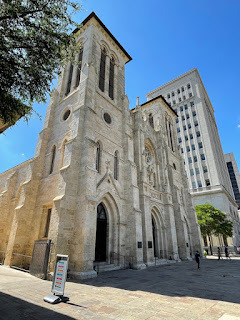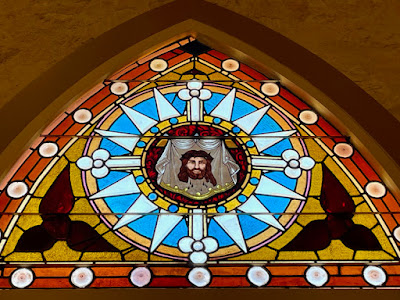And we find ourselves in Allentown - not the one that Billy Joel sings about in southeastern Pennsylvania, but the one in central New Jersey. You probably wouldn’t know it was there unless you saw the exit sign off the New Jersey turnpike. On my way from Philly up to the Freehold area in mid-April, 2022 (to meet a large group of people for a cemetery tour), I had a discretionary hour along the way, so I thought I’d check out A-Town. A quick one while he’s away, as the song by The Who goes. My neighbor told me the town was totally quaint, with Victorian style homes and old mills.
Well, my neighbor was right. Cool old small town, great place to retire to. More of a draw for me, though, was that Google Maps showed a cemetery there. A full course in noetics would be required to understand what drives me to do such things.
So about 9 A.M. one sunny spring Saturday, I jumped off the turnpike and headed into Allentown. The town itself is a couple miles off the highway, but certainly worth a cemetery road trip. The Allentown Presbyterian Church (founded 1756) has one of the most lovely and cared for graveyards I’d ever seen. Meticulously maintained, this relatively small (a few acres) plot of land has gravestones from all the major eras, beginning with colonial times, all the way to the present day. And by the way, a churchyard burial place is technically called a graveyard, not a cemetery.
 |
| Allentown Presbyterian Church |
But I’m getting ahead of myself here. Finding the graveyard was a bit challenging, as Google Maps got confused as to which side of the millpond the property was actually located. After three U-turns in the middle of the downtown area (which gave me ample opportunity to scope out the many coffee shops and diners open this fine morning), I finally spotted the tombstones through the trees, up on the hill across the pond.
Maybe you’ve been in this situation yourself – a new cemetery presents you with so many fresh opportunities, you’d don’t quite know where to start. The old church was an architectural gem, gleaming wooden white steeple, well-preserved, surrounded by dogwood trees in pink and white bloom. I immediately began photographing the wolf-table grave markers under its side windows, but then realized people were looking out at me from inside the church. Oops - there was a service was going on!
 |
| Soul effigy stone, 1762 |
 |
| Zinc, granite, and marble grave markers |
The gentle grassy hillside was perfectly manicured, the turf clipped neatly around each grave marker and monument – no small feat - and no grass clippings anywhere. Truly, as great an effort is put into preserving this remarkable graveyard, as is put into the preservation of the church building itself. It just invites people to explore and enjoy.
 |
| Shot with Leica R5 film camera |
I spent my entire discretionary hour here in this graveyard, walking, reading the stones, enjoying the view. I got to test out my new forty-year-old Leica R5 film camera with some black and white film. Here’s an image of headstones behind the church – overlooking the millpond – lit by the morning sun. I’m really happy with the way it turned out.
 |
| "Jesus is Condemned." |
You typically won’t see a crucifix in a Presbyterian church (or its graveyard, I assume), as they are not totally acceptable here. Why, you may ask? Presbyterians, like most Protestants, will typically use a cross, but not a crucifix. Their theology focuses on the risen Christ as opposed to the crucified Lord. (ref.)
When I first began printing my cemetery photography (which was initially only black and white images of stone angels) back in the early 2000s, I tried to get art galleries to exhibit my work. Many turned me down saying the work was “too religious.” Now, twenty years later, I come across this 2022 article in the National Review, “The Specter of Christianity,” in which the author, Kevin Williamson, opines that “Western civilization is Christian civilization.” He states that “Christian culture, Christian philosophy, and Christian themes dominate our art, literature, and political thinking.” So, really, there is no getting away from religion.
I suppose I could photograph the plain grave markers in non-religious cemeteries, “Strangers’ Burial Grounds,” as they used to call them. However, that would STILL refer to Christianity in much the same way that demonic metal bands like Judas Priest would have no basis for their rebelliousness if they did not have Christianity to rebel against.
 |
| Judas Priest in their current 2021-22 Fiftieth Anniversary Tour (yes, I went!) |
Williamson’s perspective on anti-religious subjects is interesting. Rob Halford, singer and songwriter for the band Judas Priest, for all their doom metal, totally define themselves in terms of what they reject. Same for Black Sabbath, Slayer, and so on. Their symbol, seen here above the stage, is of course, a variation of the cross. “The underside of Christian civilization is still Christian civilization: The Omen is a scary movie because of its religious context; we don’t have scary movies about liberal humanism or yoga, says Williamson.” We are “powerless before the cross,” he adds. To paraphrase Williamson, Halford can mock the cross or reject it, but he cannot escape it, because he has nothing to put it its place.
Soon, the congregation let out and so I ambled up the hill to the church to make some photographs of it. Noticed this historic sign nearby – I had walked right by the grave of William A. Newell (1817 – 1901) – Father of the United States Coast Guard. I walked past the few people who were gathered outside the church, chatting. Jumped in the car and took off so I could reach my next cemetery destination on time. Grab coffee at the smalltown diner in the center of town and then head out to the highway, I got nothing to lose at all...
Wolf table graves alongside church
















